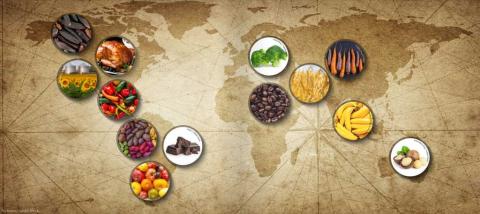We’ve all created associations between certain foods and ingredients with particular places and cultures. But the history of the origin of foods is complicated and ascertained only thanks to serious academic and scientific study. Read on to discover the lesser-known origins of popular foods.
North America - Turkey
First domesticated: Over 2,000 years ago Anasazi Ancestral Puebloans domesticated turkeys in the southwest United States and Aztecs domesticated the bird in southern Mexico.
Main migration: The Spanish took turkeys back with them to Europe, where these so-called “Indian chickens,” which were fatter and juicier than European fare, were an instant hit!
Did you know? In 1511, King Ferdinand of Spain ordered that all ships sailing back to Spain had to bring five male and five female turkeys. Wild turkeys exist today in North America thanks to reintroduction programs and hunting management.
South America - Chocolate
First domesticated: About 3,600 years ago in present-day Ecuador
Main migration: When the Aztec empire began to spread across Mesoamerica in the 1400s, they traded with the Maya for beans. Both civilizations held chocolate in high regard, using it in religious rituals and as a currency. Chocolate arrived in Europe in the 1500s, where the Spanish used sugar and cinnamon to make it sweeter. As demand grew, European nations created colonial plantations to grow cacao and sugar, importing African slaves to work on the plantations.
Did you know? The invention of the cocoa press in 1828 revolutionized production and made chocolate more affordable, and more popular, paving the way for the big business that exists today.
Europe - Broccoli
First domesticated: Derived from a kind of wild cabbage, the Brassica oleracea italica, broccoli was engineered by the Etruscans around the sixth century BC.
Main migration: Spread to France in 1533 when Catherine de Medici married Henry II, to England in the 18th century, and from there to North America in the 19th century - though it only became popular when southern Italian immigrants arrived in the 1920s.
Did you know? The Etruscans and ancient Romans loved broccoli!
Africa - Coffee
First domesticated: In Yemen in the 14th century.
Main migration: A popular beverage in Persia, Egypt, Syria, and Turkey, it was brought to Europe in the 16th century where it was dubbed the “bitter invention of Satan” by the Catholics. It then spread to South America in the 1700s.
Did you know? The top coffee producers in the world today are Brazil, Vietnam, and Colombia.
Asia - Bananas
First domesticated: The earliest evidence of banana cultivation comes from Papua New Guinea around 10,000 to 6,500 years ago.
Main migration: Bananas spread throughout Island Southeast Asia becoming a staple of Austronesian peoples, before ancient maritime trade took bananas into Oceania, East Africa, South Asia, and Indochina. By the ninth century bananas were mentioned in Islamic texts, and then they travelled into North Africa and Muslim Iberia. Bananas were introduced into South America by the Portuguese and the Spanish.
Did you know? Large scale banana plantations started in the Caribbean in the 1870s. Today bananas grow in tropical regions around the world, including Africa, China, South and Central America - the so-called ‘banana republics.’
Australia - Macadamia nuts
First domesticated: In 1858, Walter Hill planted the first cultivated Macadamia at the Brisbane City Botanic Gardens.
Main migration: In the 1870s, macadamia nuts or plants were sent to Hawaii for commercial cultivation. It was in Hawaii that research was conducted into propagation of the macadamia nut tree.
Did you know? South Africa is the leading producer of macadamia nuts. Wild trees in Australia are being lost and are considered under threat.
By Cecilia Bogaard




